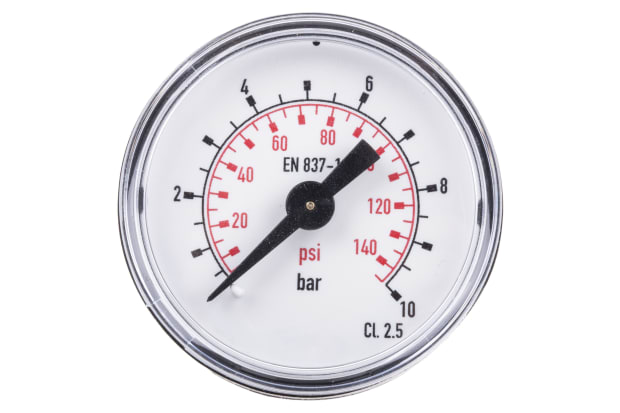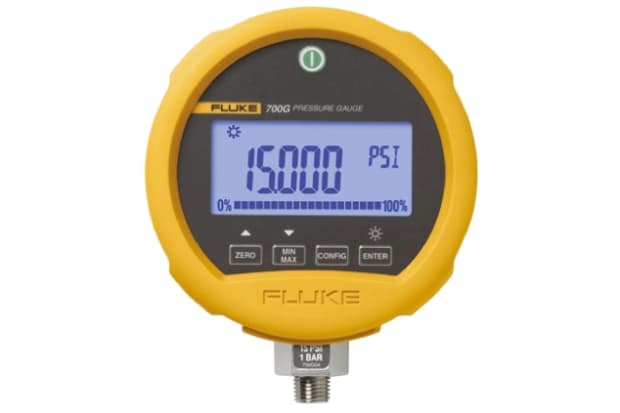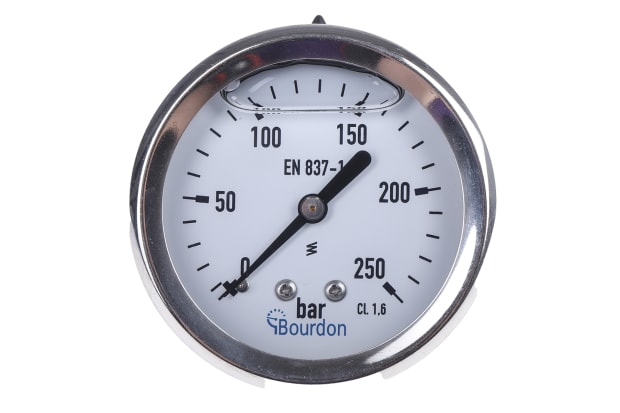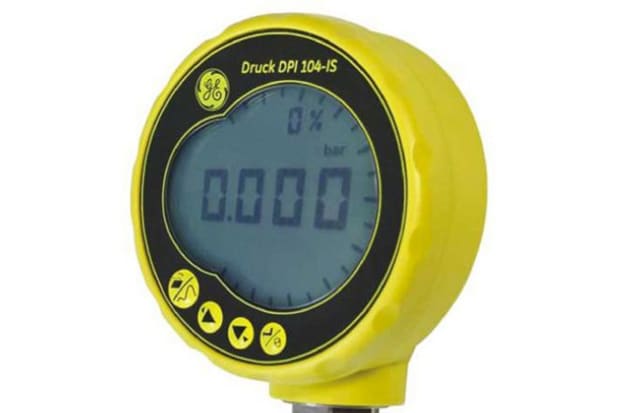- Published 24 Jan 2023
- Last Modified 3 Jun 2024
- 9 min
Pressure Gauges – A Complete Guide
Discover everything you need to know about analogue and digital pressure gauges in our comprehensive guide.

Reviewed by Osman Hafeji, Technical Support Engineer (August 2021)
What is a Pressure Gauge?
A pressure gauge is an instrument that measures the pressure of a gas or liquid relative to the atmosphere, a vacuum, or the difference between two points. Understanding the pressure gauge meaning helps in comprehending the instrument's function and significance in various applications.
Pressure gauges are used in a wide range of applications and industries. There are also many different types, each best suited to specific tasks and requirements. So, what are pressure gauges? In short, they provide a simple, straightforward means of measuring pressure.
Pressure Gauge Units
Pressure measurement uses a variety of units, including:
- Pounds per square inch (psi) - This is a common unit used in various applications, especially in automotive and industrial settings
- Bar - This unit is widely used in Europe and is common in various engineering and scientific contexts. 1 bar is approximately equal to atmospheric pressure at sea level
- Pascal (Pa) and kilopascal (kPa) - These are the SI units for pressure, with 1 bar equal to 100,000 Pascals. Kilopascals are frequently used for convenience
- Millibar (mbar) - This is often used in meteorology for atmospheric pressure
These different pressure gauge units are used depending on the specific application and industry standards.

What is Gauge Pressure?
Gauge pressure is relative to normal atmospheric pressure. Essentially, it is the deviation of pressure away from standard atmospheric pressure. It can be measured in several ways, including bar and psi. Gauge pressure is commonly used worldwide, and it is also worth noting that gauge pressure can be positive or negative.
Pressure Gauge Applications
Different types of pressure gauges are suitable for use in a wide variety of applications. They can be found in everyday domestic equipment such as boilers, heating systems, and tyre pressure monitors. However, they are also used across a diverse range of industries, including:
- Automotive
- Medical
- Food and beverage
- Manufacturing
- Energy
Some of the principal applications of these versatile instruments are explained below.
Oil Pressure Gauges
Oil gauges measure and monitor oil pressure in a variety of systems and applications. One of their most common uses is measuring oil pressure in vehicle engines, yet they can also be used for various other purposes.
Oil pressure gauges are found in a variety of applications, including:
- Automotive
- Industrial lubrication systems
- Cutting fluid systems
Pressure Gauges for Water
Water pressure gauges are instruments used in plumbing and water systems to measure water pressure. They are primarily used within the plumbing and utility industries but can also be utilised for domestic purposes. Mains water gauges are designed specifically for professional use.
Air Pressure Gauges
Air pressure gauges are used for monitoring and testing pneumatic and air systems. They are suitable for use with a wide range of devices and instruments, including air compressors, air cylinders, and tyre pressure gauges.
Air pressure gauges can test:
- Fan efficiency
- Filter conditions
- Speed (using a pitot tube)
- Air supply
Boiler Pressure Gauges
Boiler pressure gauges display the water pressure within a boiler or heating system. Standard boiler gauges measure the pressure within the system against the ambient pressure in the atmosphere. The water pressure within these systems is relatively low and typically should not be more than four bar.
These instruments are available as digital or mechanical devices, providing greater flexibility. Pressure gauges designed for boilers typically feature larger dial sizes which makes them easy to read from a distance. This is beneficial when working in potentially small or confined areas around a boiler or heating system.
Pressure Gauge Formula

The pressure gauge formula measures pressure in a system relative to atmospheric pressure. According to the pressure gauge formula:
Pg = P - Pₐ
Where:
- Pg is the gauge pressure
- P is the absolute pressure
- Pₐ is the local atmospheric pressure
In this context:
- Including atmospheric pressure, absolute pressure refers to the total pressure within a system
- The gauge pressure is the pressure relative to the atmospheric pressure. It can be positive if above atmospheric pressure or negative if below atmospheric pressure
Pressure Gauge Types
Each type of pressure gauge is best suited for a particular task. Traditional, round-style gauges are among the most common pressure gauge types. In contrast, industrial process gauges are better suited to heavy-duty applications and frequent use.
Some of the most common pressure gauge types are explored in the sections below:
Analogue Pressure Gauges
Traditional pressure gauges are analogue. To function, they rely on a needle and mechanical internals. Analogue gauges are adaptable, reliable, and accurate, and can be used in a wide variety of applications. Your normal applied pressure should be roughly half the full gauge scale when using an analogue pressure gauge.
Digital Pressure Gauges
Modern pressure gauges are electronic or digital. A diaphragm and strain gauge are typically used in these devices. Their digital displays enable them to display and record readings more easily.
Differential Pressure Gauges
In differential pressure, one pressure is measured relative to another. As a result, differential pressure gauges measure the difference in pressure between two ports. It is possible to have a positive or negative differential pressure.
Absolute Pressure Gauges
Pressure is measured relative to a vacuum with an absolute pressure gauge. This means that it reads against an absolute vacuum or complete vacuum. Therefore, absolute pressure is always positive. Gauges of this type are used when working with altimeters, barometers, and deep vacuum or atmospheric equipment.
Hydraulic Pressure Gauges
Hydraulic pressure gauges have a wider pressure range. Some models can reach hundreds of bar. Oil should be used with hydraulic gauges.
Atmospheric Pressure Gauges
Meteorologists use atmospheric pressure gauges to measure air pressure. The data they provide can be used for providing weather forecasting data and predicting weather patterns.
How Do Pressure Gauges Work?
Different types of pressure gauges work in different ways. For instance, analogue versions use a Bourdon tube, whereas digital models use strain gauges. To understand how does a pressure gauge work, the following sections provide more detail.

How Do Analogue Pressure Gauges Work?
Analogue pressure gauges feature a curved Bourdon tube. This is a radially formed tube with an oval cross-section. When in use, the Bourdon tube straightens under pressure. The gas or liquid being measured presses internally on the tube, producing motion at the non-clamped tube end. This is then indicated and used to measure pressure. The Bourdon tube is linked to the dial, and as pressure rises, the dial turns clockwise to display the pressure reading.
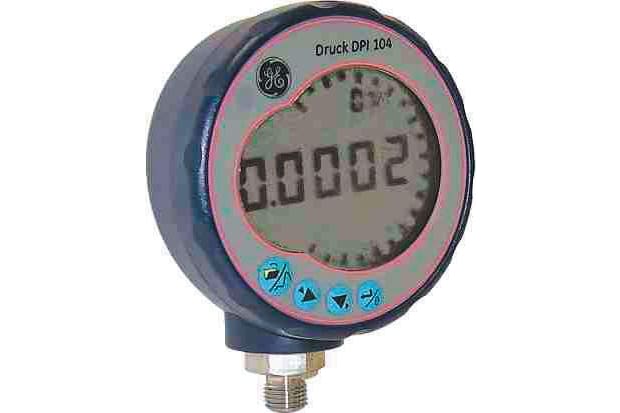
How Do Digital Pressure Gauges Work?
Digital pressure gauges feature microprocessors and advanced sensors. These are designed to measure pressure accurately, clearly displaying readings on a screen or digital indicator. Many digital models use strain gauge sensors. These work by monitoring changes in electrical resistivity when pressure is applied. These changes are then measured and the results are used to calculate the pressure reading.
How to Read a Pressure Gauge
Reading a pressure gauge involves understanding the type of gauge and interpreting the scale correctly. Here's a step-by-step guide on how to read pressure gauges accurately:
- Identify the gauge type: Analogue or digital?
- Understand the scale: Ensure you know the unit of measurement your gauge uses
- Zero the gauge: Before taking a reading, ensure that the gauge is at zero when there is no pressure applied. If the gauge is not zeroed correctly, it may need calibration
- Take the reading: For analogue gauges, observe where the needle is pointing on the dial then look at the number the needle is pointing to on the scale to read the value. For digital gauges, turn it on if it requires activation, then simply read the display and note the value shown on the screen
By following these steps, you can accurately read both analogue and digital pressure gauges.
Top Tip: Make sure your eyes are level with the gauge when reading to avoid parallax error.
Pressure Gauge Manufacturers
Pressure gauge manufacturers offer high-quality instruments for a range of applications. However, it is imperative to consider the best brand for your requirements. This is because manufacturers offer varying types, designs, and uses, so choosing the right one is key.
Some of the most popular pressure gauge manufacturers include:
WIKA
Browse the extensive range of analogue positive pressure gauges from leading brand WIKA and shop online with RS.
Fluke
Leading brand Fluke offers a wide range of high-quality digital positive pressure gauges. Shop the full range online.
Bourdon
Shop Bourdon analogue positive pressure gauges and choose the best device for your requirements today.
Druck
With a variety of different types and styles available, shop the full range of Druck digital pressure gauges with RS.
How to Install a Pressure Gauge
The exact installation method varies from one device to the next. As there are so many different types of pressure gauges available, the instrument must be fitted according to the manufacturer’s instructions for that particular gauge.
Many pressure gauges include a threaded mount. This should be placed into a manifold or pipe fitting, depending on application and gauge type. However, the location of the threads will determine how and where it can be installed.
How to Calibrate a Pressure Gauge
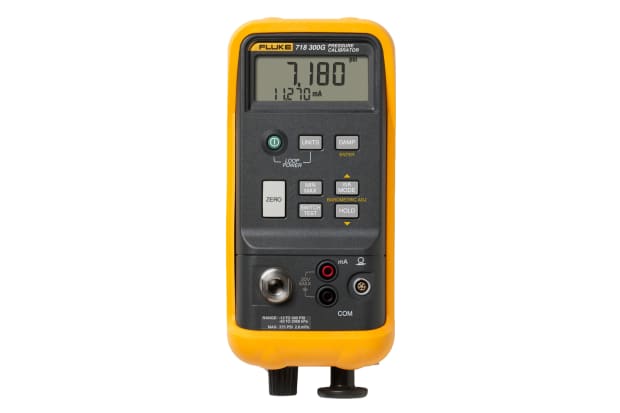
Calibrating a pressure gauge involves testing and correcting the device's accuracy. It is natural for certain types of test and measurement instruments such as these to gradually decrease in accuracy over time. Calibration is important for accurate measurements. This is especially true in applications and industries where highly precise measurements are imperative.
Pressure gauges can be calibrated in two ways. The first method involves sending the device to a dedicated calibration lab. This means experts will ensure the gauge is properly and accurately calibrated. The second method requires a hand-held pressure calibrator. These devices generate pressure from either a pump or a hand lever and allow the user to adjust the gauge accordingly.
There is no specific timeframe for pressure gauge recalibration. Certain industries or businesses – especially those in which accuracy is key – will require more frequent recalibration than other systems.
Accuracy will vary based on several factors including:
- The type of device
- The device's quality
- What it is used for
- How often it is used
- The environment it is both used and stored in
- How long has passed since it was last calibrated
- The device's age
As a result, deciding when a gauge needs recalibration is the responsibility of the user. However, as a rough guide, many industrial users prefer to get their devices calibrated annually.
